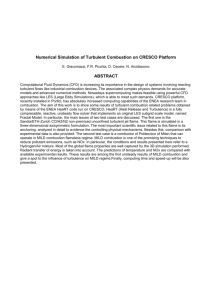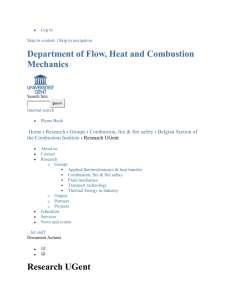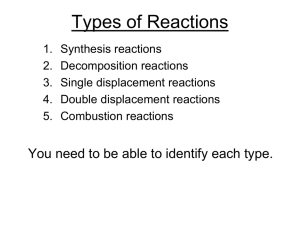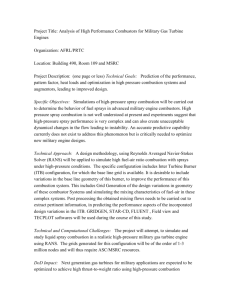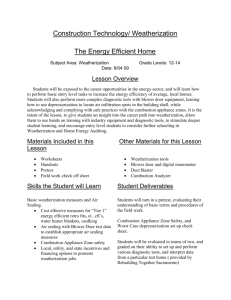Combustion Safety - Weatherization Assistance Program Technical
advertisement
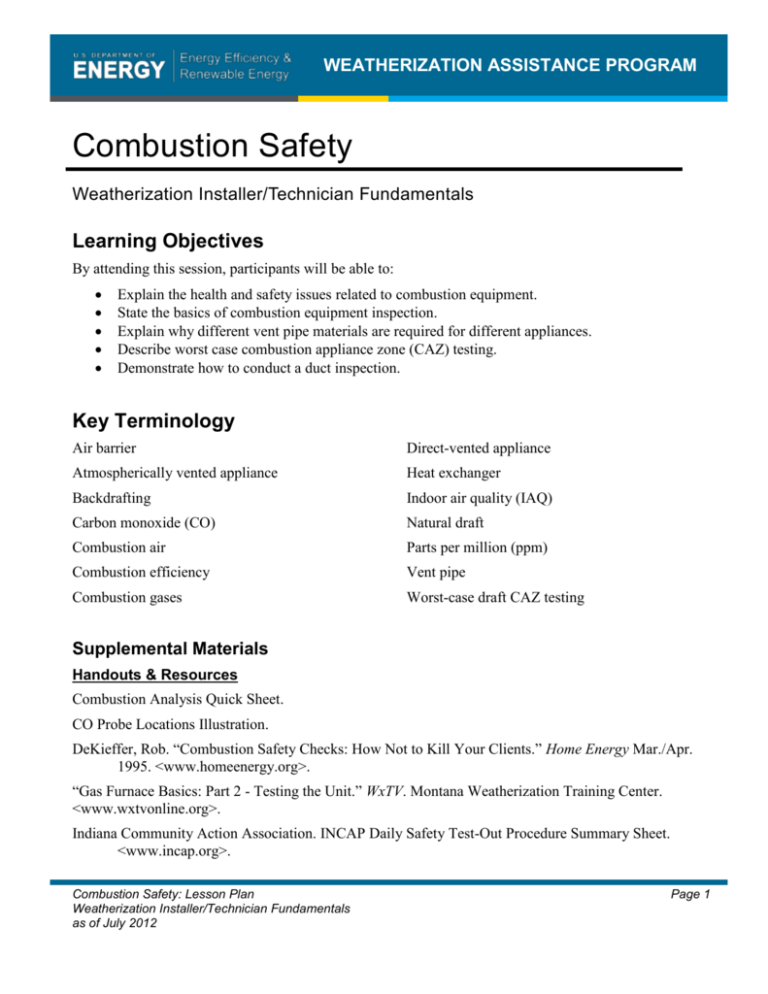
WEATHERIZATION ASSISTANCE PROGRAM Combustion Safety Weatherization Installer/Technician Fundamentals Learning Objectives By attending this session, participants will be able to: Explain the health and safety issues related to combustion equipment. State the basics of combustion equipment inspection. Explain why different vent pipe materials are required for different appliances. Describe worst case combustion appliance zone (CAZ) testing. Demonstrate how to conduct a duct inspection. Key Terminology Air barrier Direct-vented appliance Atmospherically vented appliance Heat exchanger Backdrafting Indoor air quality (IAQ) Carbon monoxide (CO) Natural draft Combustion air Parts per million (ppm) Combustion efficiency Vent pipe Combustion gases Worst-case draft CAZ testing Supplemental Materials Handouts & Resources Combustion Analysis Quick Sheet. CO Probe Locations Illustration. DeKieffer, Rob. “Combustion Safety Checks: How Not to Kill Your Clients.” Home Energy Mar./Apr. 1995. <www.homeenergy.org>. “Gas Furnace Basics: Part 2 - Testing the Unit.” WxTV. Montana Weatherization Training Center. <www.wxtvonline.org>. Indiana Community Action Association. INCAP Daily Safety Test-Out Procedure Summary Sheet. <www.incap.org>. Combustion Safety: Lesson Plan Weatherization Installer/Technician Fundamentals as of July 2012 Page 1 WEATHERIZATION ASSISTANCE PROGRAM Moffatt, Sebastian. “Backdrafting Causes and Cures.” Home Energy May/June 1991. National Fire Protection Agency. “NFPA211: Standard for Chimneys, Fireplaces, Vents, and Solid Fuel-Burning Appliances.” <www.nfpa.org>. National Fire Protection Agency. “NFPA54: National Fuel Gas Code.” <www.nfpa.org>. U.S. Department of Energy. Energy Efficiency and Renewable Energy. “Combustion Equipment Fact Sheet.” Oct. 2000. U.S. Department of Energy. Hot Climate Initiative. Combustion Appliance Safety & Efficiency Testing. U.S. Department of Energy. Weatherization Assistance Program. “WPN 11-6 Health & Safety Guidance.” 12 Jan. 2011. <www.waptac.org>. U.S. Department of Labor. Occupational Safety and Health Administration. “Carbon Monoxide Poisoning Factsheet.” <www.osha.gov>. U.S. Department of Labor. Occupational Safety and Health Administration. “Carbon Monoxide Poisoning QuickCardTM.” <www.osha.gov>. U.S. Environmental Protection Agency. “Carbon Monoxide Fact Sheet.” Oct. 1996. <www.epa.gov>. Relevant Standard Work Specifications 1.105.1 – Combustion Worker Safety 1.200 – Combustion Safety Testing Classroom Props & Activities Various types of vent connectors Gas leak detector Soap solution Mirror and flashlight Combustion analyzer Manometer and hose Gas Input Rating Demonstration Bring the students out to the building’s gas meter. Using a calibration card or table and a timer, have a pair of students determine the gas consumption of the building. Discuss the procedure for testing the fuel input of appliances at client homes. Hands-on Props Combustion appliances for inspection and testing Point out the various appliance components and have students name them. In groups, have students inspect wiring and fans and look for cracked or corroded heat exchangers and proper vent materials. Test for fuel leaks, safety shut-off, draft, free oxygen (combustion air), CO, cracked heat exchanger, and combustion efficiency. Page 2 Combustion Safety: Lesson Plan Weatherization Installer/Technician Fundamentals as of July 2012 WEATHERIZATION ASSISTANCE PROGRAM Tools: Mirror Flashlight Gas leak detector Combustion analyzer CO detector Soap solution Pipe tape and wrenches (to repair leaks) Lighter Manometer and hose High-temp caulk (if re-sealing holes) Class Overview Introduce the concepts of combustion safety with the classroom presentation. Break up the presentation by demonstrating various combustion inspection tools. Demonstrate the sensitivity of the gas leak detector by drawing a thick line on a piece of paper with a permanent marker, then showing the detector go off as it approaches the line. Demonstrate draft testing basics on an operating furnace. Refer to the Combustion Appliance Safety and Effective Testing handout for safety protocols and action levels. Show and tell chimney and vent components. Briefly review on reporting findings of combustion issues using INCAP Daily test-out procedure handout/resource. Combustion Safety: Lesson Plan Weatherization Installer/Technician Fundamentals as of July 2012 Page 3



